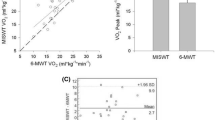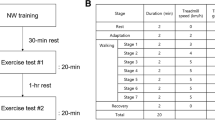Abstract
We investigated whether the spontaneous transition between walking and running during moving with increasing speed corresponds to the speed at which walking becomes less economical than running. Seven active male subjects [mean age, 23.7 (SEM 0.7) years, mean maximal oxygen uptake (\(\dot V{\text{O}}_{2\max } \)), 57.5 (SEM 3.3) ml·kg −1·min −1, mean ventilatory threshold (VTh), 37.5 (SEM 3) ml·kg −1 ·min −1] participated in this study. Each subject performed four exercise tests separated by 1-week intervals: test 1, \(\dot V{\text{O}}_{2\max } \) and VTh were determined; test 2, the speed at which the transition between walking and running spontaneously occurs (ST) during increasing speed (increases of 0.5 km·h −1 every 4 min from 5 km·h −1) was determined; test 3, the subjects were constrained to walk for 4 min at ST, at ST ± 0.5 km·h −1 and at ST ± 1 km·h −1; and test 4, the subjects were constrained to run for 4 min at ST, at ST±0.5 km·-h −1 and at ST±1 km·h −1. During exercise, oxygen uptake (\(\dot V{\text{O}}_2 \)), heart rate (HR), ventilation (\(\dot V_{\text{E}} \)), ventilatory equivalents for oxygen and carbon dioxide (% MathType!MTEF!2!1!+-% feaafiart1ev1aaatCvAUfeBSjuyZL2yd9gzLbvyNv2CaerbuLwBLn% hiov2DGi1BTfMBaeXatLxBI9gBaerbd9wDYLwzYbItLDharqqtubsr% 4rNCHbGeaGqiVu0Je9sqqrpepC0xbbL8F4rqqrFfpeea0xe9Lq-Jc9% vqaqpepm0xbba9pwe9Q8fs0-yqaqpepae9pg0FirpepeKkFr0xfr-x% fr-xb9adbaqaaeGaciGaaiaabeqaamaabaabaaGcbaGabmOvayaaca% WaaSbaaSqaaiaabweaaeqaaOGaai4laiqadAfagaGaamaaBaaaleaa% caqGYaaabeaakiaacYcacaqGGaGaaeiiaiqadAfagaGaamaaBaaale% aacaqGfbaabeaakiaac+caceWGwbGbaiaacaqGdbGaae4tamaaBaaa% leaacaaIYaaabeaaaaa!4240!\[\dot V_{\text{E}} /\dot V_{\text{2}} ,{\text{ }}\dot V_{\text{E}} /\dot V{\text{CO}}_2 \]), respiratory exchange ratio (R), stride length (SL), and stride frequency (SF) were measured. The results showed that: ST occurred at 2.16 (SEM 0.04) m·s −1; \(\dot V{\text{O}}_2 \), HR and speed at ST were significantly lower than the values measured at VTh (P< 0.001, P< 0.001 and P< 0.05, respectively); \(\dot V{\text{O}}_2 \) changed significantly with speed (P< 0.001) but was greater during running than walking below ST (ST minus 1 km·h −1, P< 0.001; ST minus 0.5 km·h −1, P< 0.05) with the converse above ST (ST.plus 1 km·h −1, P<0.05), whereas at ST the values of \(\dot V{\text{O}}_2 \) were very close [23.9 (SEM 1.1) vs 23.7 (SEM 0.8) ml·kg −1 · min −1 not significant, respectively, for walking and running]; SL was significantly greater during walking than running (P<0.001) and SF lower (P<0.001); and HR and \(\dot V_{\text{E}} \) were significantly greater during running than walking below ST (ST minus 1 km·h −1, P<0.01; ST minus 0.5 km·h −1, P{<0.05) with the converse above ST (ST plus 1 km·h −1, P·< 0.05), whereas no difference appeared for \(\dot V_{\text{E}} /\dot V{\text{O}}_{\text{2}} \) and R between the two types of locomotion. We concluded from this study that ST corresponded to the speed at which the energy expenditure of running became lower than the energy expenditure of walking but that the mechanism of the link needed further investigation.
Similar content being viewed by others
References
Astrand PO, Rodahl K (1980) Manuel de physiologie de l'exercice musculaire, 2nd edn. Translated by JR Lacour) Masson, Paris, p 505
Bobbert AC (1960) Energy expenditure in level and grade walking. J Appl Physiol 15:1015–1021
Cavagna GA, Kaneko M (1977) Mechanical work and efficiency in level walking and running. J Physiol (Lond) 268:467–481
Cavanagh PR, Williams KR (1982) The effect of stride length variation on oxygen uptake during distance running. Med Sci Sport Exerc 14:30–35
Cavanagh PR, Kram R (1985) Mechanical and muscular factors affecting the efficiency of human movement. Med Sci Sports Exerc 17:326–331
Cavanagh PR, Kram R (1989) Stride length in distance running: velocity, body dimensions and added mass effects. Med Sci Sports Exerc 4:467–479
Cavanagh PR, Davies CTM, Grieve DW, Sargeant AJ (1973) Electromyographic, kinesiological, and metabolic examination of running on a treadmill. J Physiol (Lond) 223:7P
Cotes JE, Meade F (1960) The energy expenditure and mechanical energy demand in walking. Ergonomics 3:97–119
Dean GA (1965) An analysis of the energy expenditure in level and grade walking. Ergonomics 8:31–47
Dill DB (1965) Oxygen used in horizontal and grade walking and running on the treadmill. J Appl Physiol 20:19–22
di Prampero PE (1986) The energy cost of human locomotion on land and in water. Int J Sports Med 7:55–72
Grillner S, Halbertsma J, Nilsson J, Thorstensson A (1979) The adaptation to speed in human locomotion. Brain Res 165:177–182
Luhtanen P, Komi PV (1978) Mechanical energy states during running. Eur J Appl Physiol 38:41–48
Margaria R (1938) Sulla fisiologia, e specialmente sul consumo energetico, della marcia e della corsa a varie velocita ed inclinazioni tel terreno. Atti Ace Naz Lincei 7:299–368
Margaria R, Cerretelli P, Aghemo P, Sassi G (1963) Energy cost of running. J Appl Physiol 18:367–370
Nilsson J, Thorstensson A (1987) Adaptability in frequency and amplitude of leg movements during human locomotion at different speeds. Acta Physiol Scand 129:107–114
Nilsson J, Thorstensson A, Halbertsma J (1985) Changes in leg movements and muscle activity with speed of locomotion and mode of progression. Acta Physiol Scand 123:457–475
Ralston HJ (1958) Energy-speed relation and optimal speed during level walking. Int Z Angew Physiol Arbeitsphysiol 17:5277–283
Thorstensson A, Roberthson H (1987) Adaptations to changing speed in human locomotion: speed of transition between walking and running. Acta Physiol Scand 131:211–214
Wasserman K (1978) Breathing during exercise. N Engl J Med 289:780–785
Zarrugh NY, Todd FN, Ralston HJ (1974) Optimization of energy expenditure during level walking. Eur J Appl Physiol 33:293–306
Author information
Authors and Affiliations
Rights and permissions
About this article
Cite this article
Mercier, J., Gallais, D.L., Durand, M. et al. Energy expenditure and cardiorespiratory responses at the transition between walking and running. Eur J Appl Physiol 69, 525–529 (1994). https://doi.org/10.1007/BF00239870
Accepted:
Issue Date:
DOI: https://doi.org/10.1007/BF00239870




